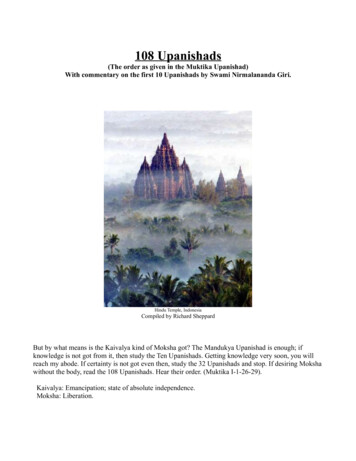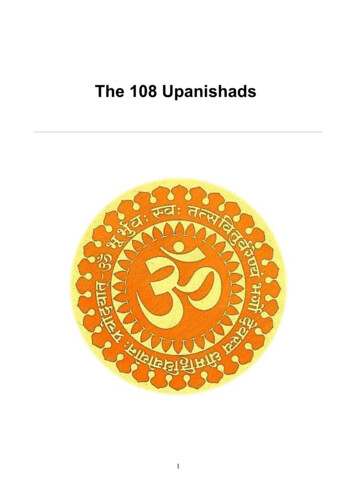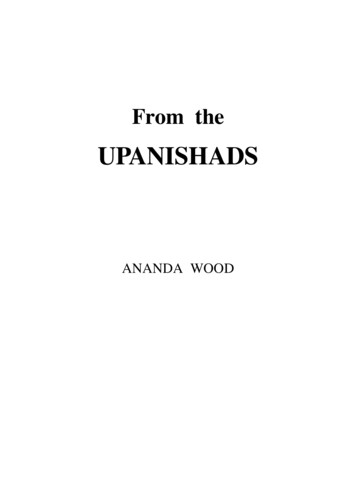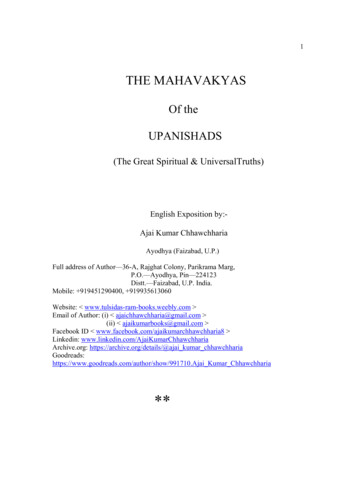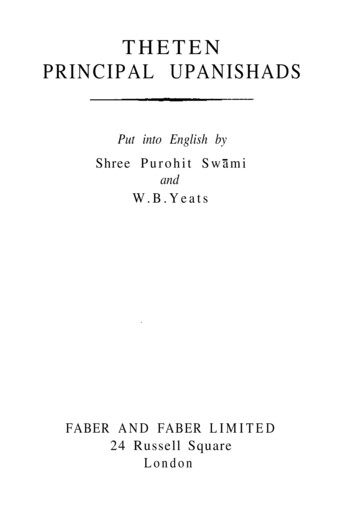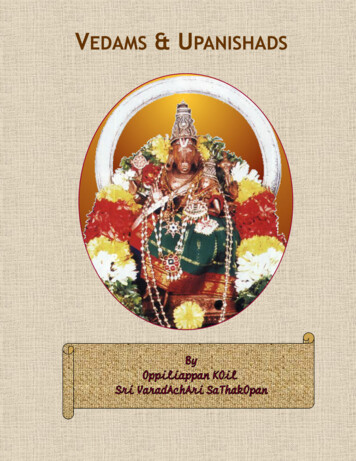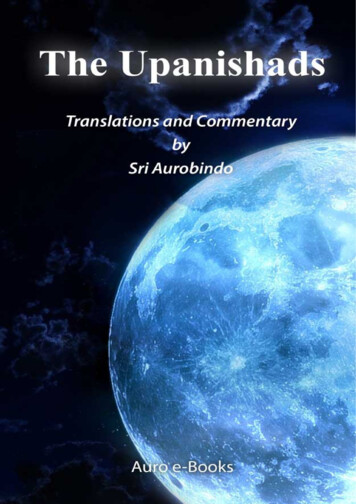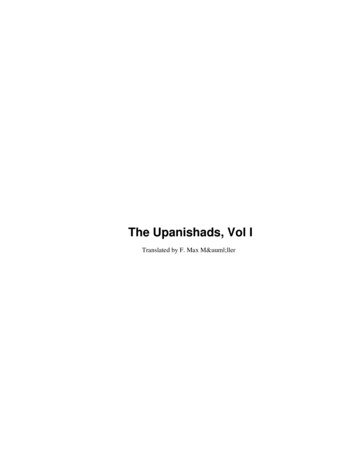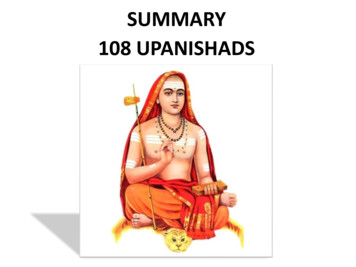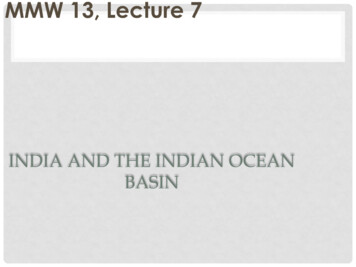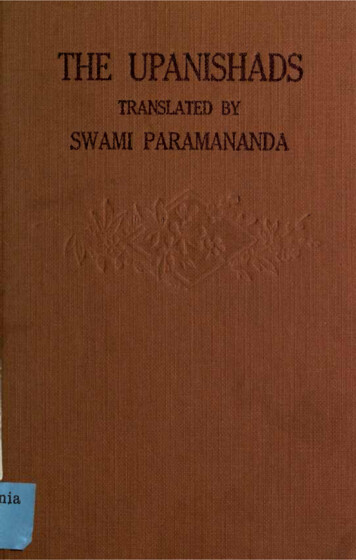
Transcription
THE UPANISHADS
BY SWAMI PARAMANANDAMyPortrait of the author.FlexibleCreed. (Poems.)2.00.Cloth, 1.50.Postage 10 cts.binding,ofFlexibleRhythm of Life. (Third VolumePoems.)Cloth, 1.50.Postage 10 cts.binding, 2.00.The Vigil. (Second Volume of Poems.) Portrait of theauthor.Flexible binding, 2.00.Cloth, 1.50.Postage 10 cts.Poems. FlexibleSoul'* Secret Door. (Second Edition.)Cloth, ink lettering,binding, gold lettering, 2.00. 1.50.Postage 10 cts.Book of Daily Thoughts and Prayers. Flexible bindings,Cloth, 2.00.Leather, 3.50. 2.75 and 2.50.Postage 15 cts.The Path of Devotion. I Sixth Edition.) Cloth, 1.00.De luxe 51.50. Postage 10 ctsThe Way of Peace and Blessedness 3rd Edition.) Portrait of author. Cloth, 1.00. Paper, 85 cts., Postage10 cts.Vedanta in Practice. (Third Edition.)Cloth, 1.00.Paper, 85 cts. Postage 10 cts.Reincarnation and Immortality.PostageCloth, 1.00.10 cts.Flexible binding, 50 cts.PostageRight Resolutions.extra.Healing Meditations.Flexible binding, 50cts.Postageextra.PRACTICAL SERIESCloth. Full set 4.25. Postage extra.Concentration* and Meditation. New Edition, 1.00.Faith as a Constructive Force.* New Edition.Self-Mastery.75c each Creative Power of Silence.Spiritual Healing.Secret of Right Activity.COMPARATIVE STUDY SERIESEmerson and Vedanta. Cloth 1.00. Post, extra.Post, extra.Cloth 1.00Christ and Oriental Ideal*.Post, extra.Plato and Vedic Idealism. Cloth 1.00.TRANSLATIONS FROM THE SANSKRIT(Third Edition.) Vol. 1. With lucid#2.00Postage 8 cts.(Fourth Edition.) Flexible cloth, goldBhagavad-Gita.Yellow cloth, ink lettering, 1.00.lettering, 1.50.Postage 6 cents.The Upanishadt.commentary.THE VEDANTA CENTRE,420 Beacon,Boston, Mass., U. S. A.ANANDA-ASHRAMALa Crescenta, Los Angeles County, California, U.S.A.
THE UPANISHADSTRANSLATED AND COMMENTATEDBYSWAMI PARAMANANDAFROM THE ORIGINAL SANSKRIT TEXTVOLUMEITHIRD EDITIONEnlargedPUBLISHED BYTHE VEDANTA CENTREBOSTON MASS USA
COPYRIGHT, 1919, BYSWAMI PARAMANANDATHE-PLIMPTON-PKESSN OHWOOD-MASS-U-S-A
Annex5015857VOLUME ISREVERENTLY DEDICATED TO ALL SEEKERSOF TRUTH AND LOVERS OF WISDOM
PREFACEA HEtranslator'sidea of rendering theUpanishads into clear simple English, accessible to Occidental readers,hadits originBoston friend in 1909.The gentleman, then battling with a fatalmalady, took from his library shelf a trans-in a visit paid to athe Upanishads and, opening it,expressed deep regret that the obscure andunfamiliar form shut from him what helationoffelt tobe profound and vital teaching.desire to unlock the closed doors ofThethisancienttreasurehouse,awakened atthat time, led to a series of classes on theUpanishads at The Vedanta Centre ofBoston duringStreet.Theits early days in St. Botolphtranslation and commentarygiven werestudious revision,thentranscribedand,were published inaftertheCentre's monthly magazine, "The Messageof theEast," in 1913 and 1914. Stillfurther revision has broughtform.itto its present
8PrefaceSowas consistent with afar asthe Sanskrit text, therendering itosoughtthat might seem obscure andWhiletothe modern mind.allconfusingretaining in remarkable measure the rhythmand archaic force of the lines, he has triednot to sacrifice directness and simplicity ofWhere he has been obliged to usestyle.thetermSanskritforlackofan exactEnglish equivalent, he has invariably interit by a familiar English word inpretedbrackets; and everything has been done toremove the sense of strangeness in order thatthe Occidental readeranalien in thenewmaynotfeelhimselfregions of thought openedto him.Even more hastheSwamistriven to keepthe letter subordinate to theScripturedocument.isTotreatitintellectual curiosityisof itsspirit.Anyonly secondarily an historicaldeeper message.as an object of mereto cheat the worldIfmankindistoderive the highest benefit from a study ofits appeal must be primarily totheit,spiritualconsciousness;andoneofthesalient merits of the present translation lies
9Prefacein this, that the translator approaches histask not only with the grave concern of thecareful scholar, but also with the profoundreverence and fervor of the true devotee.EDITORBOSTON, March, 1919
NISHAD39KENA-UPANISHAD95MUNDAKA-UPANISHAD121
INTRODUCTIONHEUpanishads represent the loftiestIndo-Aryan thought andculture.They form the wisdom portionJLheights of rma-Kdndathecon-asorsacri-In each of the four greatportion.Vedasknown as Rik, Yajur, Sama andthere is a large portion whichAtharvadeals predominantly with rituals and ceremonials, and which has for its aim to showman how bythe path of right action hemayprepare himself for higher attainment. Following this in each Veda is another portionthe Upanishad, which deals whollywith the essentials of philosophic discrimination and ultimate spiritual vision. Forcalledthisreason the Upanishads are known asis, the end or final goalthe Veddnta, thatofwisdom (Veda, wisdom; anta, end).The name Upanishad has been variouslyinterpreted.poundManySanskritclaim thatwordit isUpa-ni-shad,a comsigni-
Introduction14"fyingsitting at the feet or in the presenceof a teacher";while according to otherauthorities it means "to shatter" or "todestroy" the fetters of ignorance. Whatever may have been the technical reasonfor selecting thisdoubtedlytoname,giveaitwas chosen un-pictureofaspiring"approaching" some wise Seer inthe seclusion of an Himalayan forest, inorder to learn of him the profoundesttruths regarding the cosmic universe andseekersGod.Because these teachings were usuallygiven in the stillness ofwhere the noisesofsome distanttheretreat,world could notdisturb the tranquillity of the contemplativelife,they are known also as Aranyakas,Another reason for thisname may be found in the fact that theywere intended especially for the VdnaForestBooks.prasthas (those who, having fulfilled alltheir duties in the world, had retired to theforesttodevotethemselvestospiritualstudy).The form which the teaching naturallyassumed was that of dialogue, a form lateradopted by Plato and other Greek philosoAs nothing was written and allphers.
ittedcalledoforally,Srutis,The term washeard."1also"what5theisused in thetheUpanishads beingregarded as direct revelations of God;while the Smritis, minor Scriptures "rerevealed,corded through memory," were traditionalworks of purely human origin. It is asignificant fact thatishadsisnowheremention madeofin theUpanany author orrecorder.Nodate for the origin of the Upanishadsfixed, because the written text doescan benot limit their antiquity.makesthatbearstous.The word SrutiThe teachingages before it was setwrittenform. The text itselfanyevidence of this, because not in-probablydownclearexistedinfrequently in a dialogue between teacherand disciple the teacher quotes from earlierAs ProScriptures now unknown to us.fessorMaxMiiller states in his lecturesonthe Vedanta Philosophy: "One feels certainthat behind all these lightning-flashes ofand philosophic thought there isa distant past, a dark background of whichwe shall never know the beginning." Somereligious
16Introductionscholars place the Vedic period as far backas 4000 or 5000 B.C.; others from 2000 toBut even the most conservative1400 B.C.admit thatitbyantedates,cen-severalwhichturies at least, the Buddhistic periodbegins in the sixth century B.C.The value of the Upanishads, however,does not rest upon their antiquity, but uponthe vital message they contain forandallliarlyTherepeoples.or localracialalltimesisinnothing pecuthem. The en-nobling lessons of these Scriptures are aspractical for the modern world as theywere for the Indo-Aryans of the earliestVedic age. Their teachings are summedupinM aha-Vdkyamtwoor"great say-twam asi (That thou art)and Aham Brahmdsmi (I am Brahman).This oneness of Soul and God lies at theTatings":very root ofallVedic .thought, anditisthis dominant ideal of the unity of all lifeand the oneness of Truth which makes thestudy of the Upanishads especially beneat the presentOne of the mostficialOrientalists our attentionfundamental dogmaofthe
Introduction17Vedanta system)in its philosophical simastheplicityidentity of God and the Soul,the Brahman and the Atman, it will befoundfarpossess a significance reachingbeyond the Upanishads, their time andtocountry; nay, we claim for it an inestimablevalue for the whole race of mankind.Whatever new and unwonted paths thephilosophy of the future may strike out,this principle will remain permanently unshaken and from it no deviation can possibly take place.If ever a general solutionreached of the great riddlethe keycan only be found where alone the secretis.open to us from within, thatto say, in our innermost self.It wasof nature ds,mortal honor, found it.".Thethetooriginaltheirim-.introduction of the Upanishadsto the Western world was through a transfirstmade in the .seventeenthMore than a century later the disFrench scholar, Anquetil Du-lation into Persiancentury.tinguishedperron, brought a copy of the manuscriptfrom Persia to France and translated it intoFrenchandLatin,publishingonlythe
1Introduction8LatinDespite the distortions whichtext.musthavefromresultedtransmissionthrough two alien languages, the light ofthe thought still shone with such brightnessdrew from Schopenhauer the ferventwords: "How entirely does the Oupnekhatthatit(Upanishad)spirittheofbreathe throughout the holyVedas! How is every one,who bya diligent study of its Persianhasbecome familiar with that inLatinbook, stirredcomparablebyto the very depth of his Soul!thatspiritFrom everysentence deep, original and sublime thoughtsarise, and the whole is pervaded by a highand holy and earnestspirit."Again hesays: "The access to (the Vedas) by meansof the Upanishads is ineyes the claim beforeThistestimonyyoungalliscenturyprevious cen-borne out bythe thoughtful American scholar, Thoreau,who writes: "What extracts from theVedasofahave read fall on me like the lighthigher and purer luminary whichIdescribes a loftier course through a purerstratumuniversal."freefromparticulars,simple,
IntroductionThefirst19English translation wasa learned Hindu, Rajamade byRam Mohun RoySince that time there nch, German, Italian and English. But.a mere translation, however accurate andsympathetic,ismakenot sufficient toaccessibletothetheOccidentalUpanishadsmind. Professor Max Miiller after a lifetime of arduous labor in this field franklyconfesses: "Modern words are round, an-words are square, and we may aswell hope to solve the quadrature of thecircle, as to express adequately the ancientthought of the Vedas in modern English."cientWithout a commentarytoitispracticallyunderstand either thespiritimpossibleor the meaning of the Upanishads. Theywere never designed as popular Scriptures.They grew upessentially as textandbooks ofSelf-knowledge, andGod-knowledgebooks they need interpretation.Being transmitted orally from teacher todisciple, the style was necessarily extremelycondensed and in the form of aphorisms.The language also was often metaphoricaland obscure. Yet if one has the perselike all text
2OIntroductionverance to penetrate beneath these meresurface difficulties, one is repaid a hundredfold;for these ancient SacredBooks containthe most preciousgems of spiritual thought.Every Upanishad begins with a PeaceChant (Shanti-patha] to create the properatmosphere of purity and serenity. Tostudy about God the whole nature mustbe prepared, so unitedly and with lovinghearts teacher and disciples prayed to theSupreme Being for His grace and protecIt is not possible to comprehend thetion.subtle problems of life unless the thoughtistranquil and the energy concentrated.Untilmindouriswithdrawnfromthevaried distractions and agitations of worldlyaffairs, we cannot enter into the spirit ofNo study is ofreligious study.avail so long as our inner being is not at-highertuned.Wetowardsall livingwe mustmust hold a peaceful attitudethings; and if it is lacking,striveferventlytocultivateitthrough suggestion by chanting or repeatingsome holy text. The same lesson is taughtby Jesus the Christ when Hesays:thou bring thy gift to the altarand there"Ifrememberest that thy brother hath aught
Introduction21against thee; leave there thy gift beforethe altar and go thy way; first be reconciledtoofferthythy brother, and then come andgift."Bearingminds,letthis lofty ideal ofus try topeace in ourmake ourhearts freefrom prejudice, doubt and intolerance, sothat from these sacred writings we maydraw in abundance inspiration, love andwisdom.PARAMANANDA
ISA-UPANISHAD
This Upanishad derives"God-covered."Isa-vasya,from the opening words,The use of Isa (Lord)aits titlemore personal name of the Supreme Being than Brahman,Atman or Self, the names usually found in the Upanishadsconstitutes one of Us peculiarities. It forms the closing chapter of the Yajur-Veda, known as Shukla (White).Oneness of the Soul and God, and the value of both faithand works as meansthemes of thisUpanishadsisof ultimate attainment are the leadingThe general teaching of theUpanishad.that works alone, even the highest, can bringonly temporary happiness and must inevitably bind a man,unless through them he gains knowledge of his real Self.TohelpallUpanishads.him acquirethisknowledgeis theaimof thisand
ISA-UPANISHADPEACE CHANTThatenal);Invisible- Absolute)(theOM!whole; wholeis this(the visibleisphenom-from the Invisible Whole comes forththe visible whole.Thoughthe visible wholehas come out from that Invisible Whole, yettheWhole remainsunaltered.OM! PEACE! PEACE! PEACE!'TpHEindefiniteterm"That"isused in the Upanishadsto designate the Invisible- Absolute, becauseorna
PREFACE AHEtranslator'sideaofrenderingthe UpanishadsintoclearsimpleEnglish,ac- cessibletoOccidentalreaders,haditsorigin inavisitpaidtoaBostonfriendin1909 .
